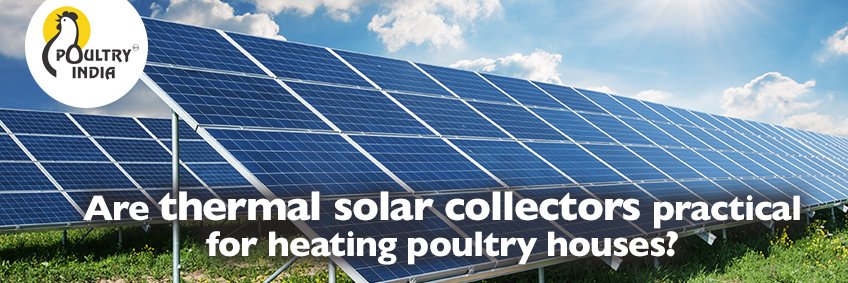Are thermal solar collectors practical for heating poultry houses?

Transpired solar collectors initially were developed to heat air using a perforated metal panel which is painted black. When sunlight hits the collector's black perforated surface, 96 percent of the sunlight and infrared waves are absorbed by the black surface. Then, before the heat can be released back into the surrounding cooler air, the heat is instead pulled through the collector's perforations and into a duct area behind the collector, and the heated air is vented into the building or its HVAC system. This type of system has been utilized to heat air in buildings since the 1980s; the only problem has been the time required to pay back the cost of the system.
Finding a less expensive alternative
Sunreps, a small startup company, has developed a transpired solar collector where a woven geotextile is used to replace the perforated metal panel. Substituting the fabric for metal drastically reduces the cost of the collector and increases the possibility that transpired solar collectors could save money for poultry growers.
Michael Czarick, engineer, poultry science department, University of Georgia, is conducting tests on the fabric solar collector at the University’s research farm.
“A number of scientific studies have been conducted on use of this particular type of fabric as a solar collector," he said. "So we know, theoretically, how the fabric will perform. The challenge is coming up with a system that can put the technology to use on a poultry farm. We have a prototype system that will essentially act like an additional furnace. If the air gets hot enough inside the solar collector tube, and the house needs heat, a fan will turn on, blowing the warm air into the house. In addition to coming up with the system, we now need to document the cost effectiveness of the system. What makes the concept so attractive is that the system is made of very inexpensive materials and should be relatively easy to construct.”
Preheating outside air
The solar collector will be used to preheat air that will be pushed into the poultry house by a fan. The collector will work best when it is in full sun and the fan is running continuously. Ventilating in this way differs from the typical system of running a fan or fans on timer for a certain length of time every five or 10 minutes. A continuous low-flow of air might have some advantages over short periods of timer fan every 10 minutes.
Another difference that might be seen when operating this solar system is a reduction in the amount of ventilation that is needed to maintain air quality within the house. Combustion of propane in the house produces heat, water vapor and carbon dioxide. Humidity in the house plays a significant role in ammonia formation in the litter or manure. By reducing the amount of gas burned, using a transpired thermal solar collector could reduce the amount of air that has to be exhausted from the house to keep the litter dry and ammonia levels low.
Potential uses
The most obvious application for this type of solar system would be any animal production facility with a high heat demand. Logical possibilities include buildings housing young pigs, broiler chicks, turkey poults or layer pullets. As the U.S. layer industry moves in the direction of housing systems that provide more space per hen, like enriched cages and cage-free, the benefits of providing supplemental heat to layer houses to maintain bird efficiency and health and meet animal welfare certification guidelines may be proven. Potential applications where supplemental heat might prove cost effective may be found on cage-free farms, because the lower housing density means fewer BTUs of heat are produced by the hens per cubic foot of house space, and the litter areas require more ventilation to keep ammonia concentration in the house air at acceptable levels.
Sources: https://www.wattagnet.com/









.jpg)



